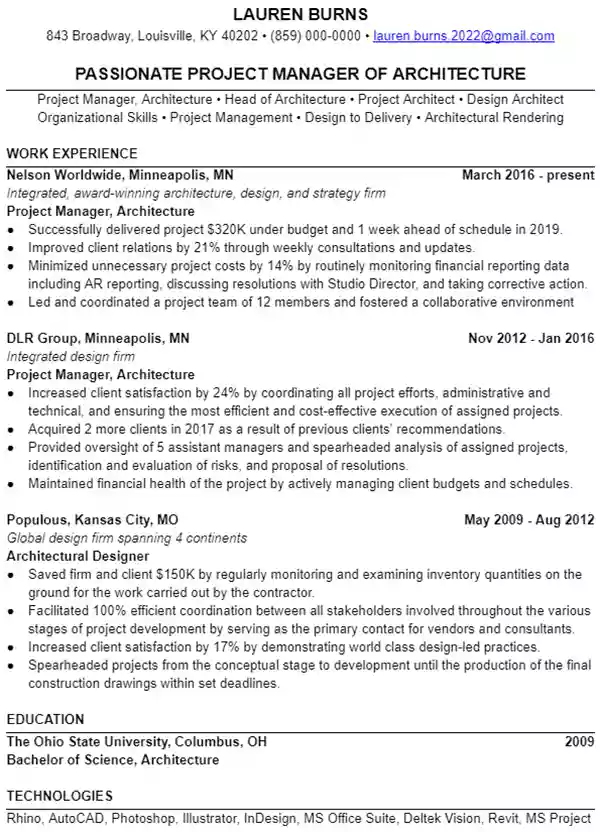Architecture Resume Example
Design the perfect Architecture resume that meets your career’s specifications with our short resume writing guide. At Leet Resumes, we write personalized resumes free of charge.


How to write a great Architecture resume
Believe it or not, writing a great resume isn’t all that different from a career in Architecture.
Creativity is an absolute must as an Architect, but you know practicality matters just as much.
A new design or blueprint may be an absolute masterpiece, but if it violates a zoning ordinance or pushes the project over budget it’ll never be built!
Success in Architecture comes down to far more than aesthetics, and the same can be said for a great resume.
If you want your resume to attract more job interviews and opportunities, gimmicky layouts or flashy designs won’t cut it.
A great Architecture resume lets the content (your career!) speak for itself, all while presenting the information in the best format possible.
Learn how to structure your resume the right way by following our step by step guide below.
If you don’t think resume writing is for you, consider contacting Leet Resumes to write yours.
We write personalized resumes - for free!
Why you need a great Architecture resume
While writing a fantastic resume, it’s essential to maximize the value of every word. There’s only so much space on a one page resume.
You can relate. Architecture frequently comes down to doing the most you can with the space allotted.
If you’re wondering how to make the most out of your one page resume, the answer is structure.
A great resume and a sturdy building share one major trait: structural integrity.
Your resume’s #1 job is to show readers you’re incredible at what you do, as clearly and quickly as possible. Our format will show you how to structure your resume the right way.
You know you’re a great Architect, but don’t assume recruiters and hiring managers know.
We’ve written countless resumes in our day, and along the way we’ve perfected the ideal resume format. Ready to learn more?
How to format your Architecture resume
Here’s the blueprint for an eye catching Architecture resume:
- Name + Contact
- Professional Headline
- Professional Summary
- Work Experience
- Education
- Keywords
You can go ahead and shorten your estimated resume writing timeline now. This format will help you construct a winning resume as fast as possible.
The tiny details matter, so let’s take a few more minutes and go over each section of your resume.
Name + Contact
Unless you want the job to go to John or Jane Doe, you’re going to want to write your full professional name at the very top of your Architecture resume. Your name should be slightly larger than the rest of the text throughout the document.
Once readers know your name, they need to know where to reach you. Write down your email address and phone number. Remember to only use a formal, professional email address. Feel free to add your LinkedIn profile as well if you log on every day.
Professional Headline
When you present a new design proposal to a client, your goal is to capture their interest and never let it go. Here is where you can begin to apply the same strategy to your resume.
Your professional headline should tell readers what you’re all about - using just three to five words. What type of Architect do you see yourself as?
Here are some examples: “Highly Skilled Commercial Architect” or “Creative Architectural Designer”.
Maybe you’ve decided you would rather have Leet Resumes write your resume for you.
No Problem. We can do that - for free!
Professional Summary
Now that you’ve set a solid foundation with the professional headline, you can start summarizing the past, present, and future of your Architecture work.
This section should feature at least two lines, or a maximum of four (depending on your experience). Each line will highlight a different chapter of your work: What you want to do next, your top skills, achievements, and any awards of promotions.
Line one is for the job titles you want to accept as your next role, such as “Lead Architect” or ”Commercial Architect”. These don’t have to be titles you’ve already held; this section is about your next role!
Line two is for your most advantageous Architectural skills. For instance, design concepts, attention to detail, budget planning, or client relations / project presentations.
Line three is where we cross over into optional territory. If you have enough experience, this line can be used to show off your biggest career achievements or accomplishments. Go on, don’t be modest.
Line four is optional. If you’ve received any awards or been promoted during your career, list those accolades here.
Work Experience
This will be the largest and arguably most important part of your resume. Completing this section the right way is key to racking up more job interviews.
In reverse chronological order list your professional job history. Underneath each listed position add a few bullet points documenting your time on each job.
It seems simple enough, but this section can actually fall apart quickly if you aren’t careful. Follow these tips to succeed:
Point to success
You’re making a major mistake if you just list your expected job duties and responsibilities under each position. Recruiters and hiring managers want to learn about you, not the general gist of being an Architect.
Every single bullet point in your work experience section should describe a career win, accomplishment, or achievement. Get specific: approved designs, finished projects, negotiated contracts, etc.
Keep in mind that this isn’t about showing off. These successes should quickly and decisively tell the reader you’re more than qualified for the job.
Numbers make a difference
Using numbers to quantify and validate your career achievements adds another layer to your work experience section. Recruiters’ eyes these days are instantly drawn to numbers because they can tell a story in a fraction of the time that it takes words. Add as many numbers as you can. The more the better!
Your work as an architect should provide no shortage of potential numbers, statistics, and other metrics to choose from. How many building projects have you overseen to completion? How much are those properties worth today?
Cut to the chase
Brevity and conciseness are essential to resume success. You want each one of your bullet points to pop off the page as soon as recruiters start reading. A great way to ensure that happens is by leading off with an action verb. By “cutting to the chase” immediately, you let readers know that you’re a go-getter who wastes no time getting things done.
Here’s an example: “Inspected over 80 building sites, ensuring compliance with all state and federal regulations.”
Notice how in just one sentence you touched on an accomplishment, used a number, and started with a verb.
Always mention promotions
Never neglect to mention promotions! A promotion tells recruiters, hiring managers, and anyone else reading that you’re very capable at your job.
Success begets success and displaying promotions in a prominent spot on your resume informs readers that you’re going to succeed in the future. The only question is will it be for their company?
Liars never get the job
Always remain 100% honest while writing your resume. Don’t embellish any position titles you held in the past and definitely don’t skip over any gaps in your work history.
People understand nowadays that there’s more to life than business, but few hiring managers will look the other way when it comes to a flat out lie. If you haven’t worked in a year or two, be upfront about it. Many job openings will at least give you an opportunity to explain what you’ve been up to.
Education
Once you’ve finished the work experience section, it’s time to touch on your educational background. Luckily, this area requires far fewer details.
Just name the schools you attended and the degrees you’ve earned. Any additional relevant Architecture certifications or licenses (LEED, NCARB) can go here as well.
It isn’t a good idea to add any degrees you haven’t finished.
Keywords
The final section of your resume is for adding any additional soft skills, hard skills, or awards you haven’t mentioned already. Referred to as “keywords,” these terms are exactly what recruiters are looking for - literally.
When a recruiter sits down to sort through resumes, he or she usually has a list of keywords handy as a reference point. More relevant keywords means a better chance they stop for an extra moment on your resume.
Here are some keywords you may want include:
- CAD software
- Organization
- Blueprints
- Revit
- Project proposal
What if I don’t have time to write a resume?
Resumes don’t write themselves. Or do they?
Leet Resumes is always available to write your Architecture resume for you.
We write personalized resumes for free, but tips are appreciated!










